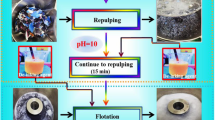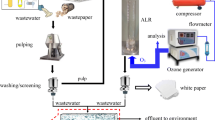Abstract
Wastepaper is the largest fraction of solid waste. Flotation deinking plays an essential role in the product quality and process cost of wastepaper recycling. This paper investigated the effect of ink types and printing processes on flotation deinking. Examination of ink types in this study revealed that newsprint oil-based offset-cold and offset-heat inks contain substantial oil (45 to 60%) and resin (5 to 35%); water-based ink contains water (40%) and resin (polystyrene, 30%); and these inks are liquids with densities around 1 g/cm3 at 25 °C. On the other hand, photocopy and laser-print toners were found to be solid powders with particle diameters of about 20 μm, densities of 1 to 1.5 g/cm3, and a composition that consists primarily of styrene-acrylate copolymers (60 to 90%). Except for water-based ink, which is water soluble, all inks in their initial state are hydrophobic. It was found that for newsprint oil based offset-cold inks there is little change in their surface chemical properties, and their hydrophobic character is retained. These inks in the newsprint wastepaper pulp can be effectively removed by flotation. On the other hand, it was found that during the printing processes, the toner particles undergo polymerization (fusion) and oxidation with the subsequent formation of peroxide bonds due to exposure to heat, light, and oxygen (air). The fusion due to polymerization causes bonding to the paper fibers and the creation of larger toner particle sizes. The oxidation creates a greater polarity at the toner particle surface. These effects account for the poor efficiency in the flotation deinking of office waste. In order to improve office wastepaper recycling, it is evident, based on this study and policy considerations, that there is a need to find ways of improving the efficiency and effectiveness of flotation deinking by modification of the surface properties of printed toner particles, or designing new toner particles.
Similar content being viewed by others
References
Basta N (1991) Recycling everything: part 3, paper recycling’s new look. Chemical Engineering p 45
Stanley GL (1996) Third year of record sales expected for U.S. paper and related industries in 1996. Tappi J 79:37–42
Sorenson D (1991) Environmental concerns, economics drive paper recycling technology. In: Patrick KL (ed) Paper recycling: strategies, economics and technology. Miller Freeman Inc., New York, pp 63–64
Claydon P (1990) Recycled fiber: the major furnish component in quality newsprint production. Pulp & PaperCanada 91:135
Raysbro Oye (1991) Utilization of waste recycling technology. Kagaku Kogaku 55:27
Rathje WL (1991) Once and future landfills. Nat Geogr (May 1991):116
Mckinney RWJ (1993) Environmental labeling of paper products. Prog Pap Recyc (Feb. 1993):15-23
Makoto I (1990) Trends in paper waste recycling technology. Kami Parupu Gijutsu Taimusu 33:6
Stork G, Pereira H, Wood TM, Dusterhoft EM, Toft A, Puls J (1994) Upgrading of recycled pulps by enzymatic treatment. Proc TAPPI Recycling Conf, pp 107–117
Anon (1994) Industry attains 40% recovery, announces 50% goal by 2000. Pap Recyc 5:1,7,8
Anon (1994) Paper industry hikes its recovery goal to 50%. Recyc Pap News 4:10
Uutela E (1991) The future of recycled fiber for different grades. Pap Technol 32:49–49
Crow DR, Secor RF (1987) The ten steps of deinking. Tappi J 70:101
Carr WF (1991) New trends in deinking technology, removing difficult inks from wastepaper. Tappi J 74:127–132
Makoto H (1990) Paper waste recycling and role of chemicals. Kagaku Gijutsushi MOL 28:40
Hideaki U, Tetsuji I (1990) Development of ink removing agents for waste paper recycling. Nikkakyo Geppo 43:10
Shrinath A, Szewczak JT, Bowen IJ (1991) A review of ink-removal techniques in current deinking. Technol Tappi J 74:85
Putz HJ, Torok I (1989) Deinking of various printing inks paper Paper 43:V48
Grossmann H, Baumgarten HL (1990) The deinkability of newspaper. Wochenbl Papierfabr 118: 217
Klaus S (1990) Chemical system in a wash deinking. Wochenbl Papierfabr 118:233
Gammauf EG (1990) Flotation deinking compared with wash deinking. Wochenbl Papierfabr 118:761
Marchidon L, Lapointe M, Chabot B (1989) The influence of particulate size in flotation deinking of newsprint. Pulp Pap Can 90:90
Andy H (1989) Flotation deinking is critical in unit process method of deinking. Pulp Pap p.60
Kishore K, Verneker VRP, Gayathri V (1980) Kinetic studies on thermal decomposition of polystyrene peroxide. J Anal Appl Pyrol 1:315
Blazso M, Varhegyi G, Jakab E (1980) Pyrolysis-gas chromatography of styrene-acrylonitrile copolymers. J Anal Appl Pyrol 2:177
Meyer HJ, Kretzschmar R (1969) Arzneimitted-forsch 19:617
Budavari S (1989) The Merck index, 11th ed. Merck & Co. Inc., Pahway, p. 1397
Yu Q, Ye Y, Miller JD (1992) Dispersion and aggregation of newspaper pulps for fiber recovery by deinking flotation. Proc Eng Found Conf, Palm Coast, Fl, pp 365–381
Badar TA (1993) Environmental impact of recycling in the paper industry. Progr Pap Recyc pp 42–52
Burstall ML (1987) Inks and deinking — problems and prospects. Pap Technol Ind 26:327
Larsson A, Stenius P, Oedberg L (1985) Surface chemistry in flotation deinking, part 3. Deposition of inks and calcium soap particles on fiber. Sven Papperstidn 88:R1
Larsson A, Stenius P, Oedberg L (1984) Surface chemistry in flotation deinking, part 1 and 2. Sven Papperstidn 87:R158
Pfalzer L (1983) Removal of printing ink by washing or flotation. Comparison from the process engineering and application industrial viewpoints. Wochenbl Papierfabr 111:127
Hornfeck K (1982) Flotation aids and their effect on the deinking process. Wochenbl Papierfabr 110:154
Herbert O, Peter W (1982) Flotation — deinking process and machines. Wochenbl Papierfabr 110:343
Boriss P, Bradl S, Mueller R (1985) Use of chemicals in various stage of the flotation deinking process. Wochenbl Papierfabr 113:650
Chamblee JW, Greenwood BF (1991) Evaluation of high throughput, high consistency deinking technology. Proc TAPPI, Orlando, Florida
Kamyr Inc. (1991) Kamyr systems — recycled fiber. Bull No KGD1816-WN591
Larsson A, Stenius P, Oedberg L (1986) The behavior of printing ink particles in flotation deinking. Wochenbl Papierfabr 114:235
Mcbride D (1990) Separate pulping of magazines, ONP yield cost, consistency benefits. Pulp Pap p. 156
Dodson M, Dean L (1990) Proper deinking chemistry, bleaching technique crucial to pulp brightness. Pulp Pap p. 190
Hornfeck K (1987) Chemicals and their mode of action in the flotation deinking process. Cons Recyc 10:125
Anders B (1986) The complete deinking line for printing and writing end use. IPPTA 23:88
Gilkey M, Shinohara H, Yoshida H (1988) Cold dispersion unit boosts deinking efficiency at Japanese tissue mills. Pulp Pap p. 100
Nie X, Miller JD (1997) The effect of ink types and printing processes on flotation deinking. Proc 1997 TAPPI Recycling Symposium, Chicago, pp 131–165
Nie X, Miller JD (1995) Thermogravimetric/mass spectrometric (TG/MS) characterization of toner particles from photocopied wastepaper and the impact of these features on flotation deinking. Proc 1995 TAPPI Pulping Conference, Chicago, pp 179–202
Nie X, Liu K, Maswaseh W, Tripathi A, Meuzelaar HLC (1994) Investigation of physical control mechnisms in the thermal decomposition of coal by means of on-line mass spectrometric techniques. ACS preprints, Div Fuel Chem 38:558
Nie X, Shen Y, Arnold NS, Meuzelaar HLC (1993) Studies of Argonne coals using a combined thermogravimetric pyrolysis mass spectrometer. 16th Symp Rocky Mountain Fuel Soc, Salt Lake City
Evans RJ, Milne TA, Soltys MN (1986) J Anal Appl Pyrol 9:207
Dworzanski JP, Buchanan RM, Chapman JN, Meuzelaar HLC (1991) Characterization of lignocellulosic materials and model compounds by combined TG/(GC)/FTIR/MS. ASC Preprints, Div Fuel Chem 36:725
Leach RH, Pierce RJ (1993) The printing ink manual, fifth ed. Blueprint, New York
Kishore K, Verneker VRP, Gayathri V (1980) Kinetic studies on thermal decomposition of polystyrene peroxide. J Anal Appl Pyrol 1:315
Blazso M, Varhegyi G, Jakab E (1980) Pyrolysis-gas chromatography of styrene-acrylonitrile copolymers. J Anal Appl Pyrol 2:177
Meyer HJ, Kretzschmar R (1969) Arzneimitted-forsch 19:617
Budavari S (1989) The Merck index, 11th ed. Merck & Co. Inc., Pahway, p. 1397
Mizes HA (1994) Adhesion of small particles in electric field. J Adhes Sci Technol 8:937
Pan R, Paulsen FG, Kocer H, Nerez R, Johnson DA, Bousfield DW, Thompson EV (1994) A global model for predicting flotation efficiencies. Proc 1994 TAPPI Recyc Symp p. 291
Vidotti RM, Johnson DA, Thompson EV (1995) Hydronamic particle volume and its relationship to mixed office waste paper flotation efficiency. Part I. Proc 1995 TAPPI Pulping Conf, Chicago, p. 203
Azevedo MAD, Miller JD, Chamblee JW (1997) Magnetic separation for wastepaper recycle mills. Proc 1997 TAPPI Recyc Symp, Chicago
Flint Ink Cor. Material safety data sheet of water based ink. MSDS 241
Xerox Cor. Material safety data sheet of 1040 dry ink plus. MSDS No:A-0024
Canon Inc. Material safety data sheet of EP-S cartridge. Canon item no:R64-0001
Author information
Authors and Affiliations
Corresponding author
Rights and permissions
About this article
Cite this article
Nie, X., Miller, J.D. & Yeboah, Y.D. The effect of ink types and printing processes on flotation deinking efficiency of wastepaper recycling. Environmental Engineering and Policy 1, 47–58 (1998). https://doi.org/10.1007/s100220050005
Received:
Published:
Issue Date:
DOI: https://doi.org/10.1007/s100220050005




